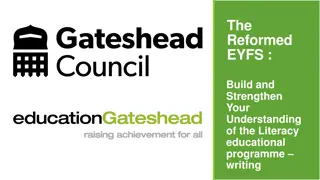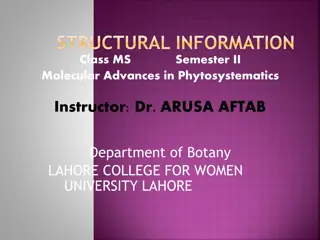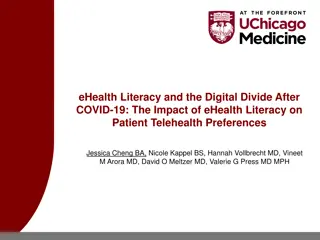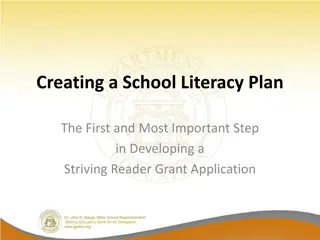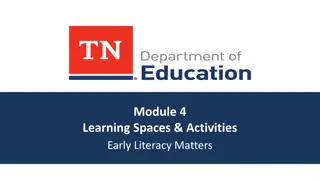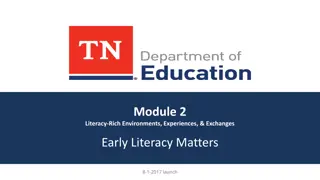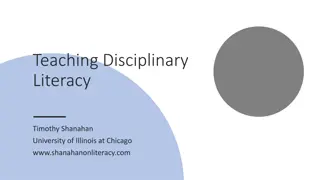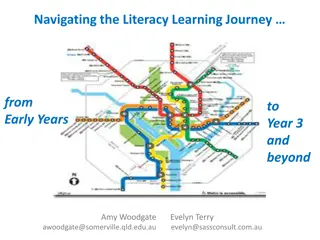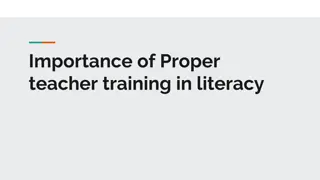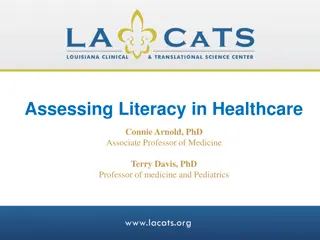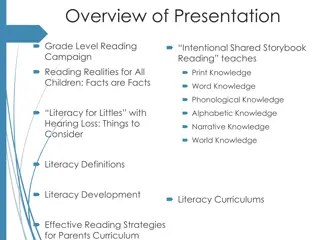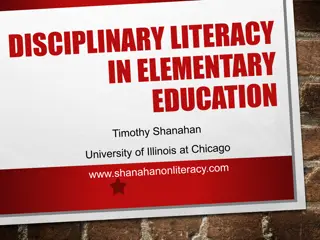Exploring the Impact of Morphological Knowledge on Literacy in Dyslexic Children
Understanding morphology and its role in literacy development among dyslexic children is crucial. This study delves into the relationship between morphological awareness, phonological difficulties, and literacy success. It also investigates the effectiveness of morphological approaches in supporting dyslexic children's literacy skills. Examples illustrate how morphological knowledge can enhance spelling and vocabulary acquisition in both typically developing and dyslexic children.
Download Presentation

Please find below an Image/Link to download the presentation.
The content on the website is provided AS IS for your information and personal use only. It may not be sold, licensed, or shared on other websites without obtaining consent from the author. Download presentation by click this link. If you encounter any issues during the download, it is possible that the publisher has removed the file from their server.
E N D
Presentation Transcript
Could morphological knowledge improve literacy in dyslexic children? Professor Julia Carroll Coventry University
Structure 1. What is morphology? 2. Is morphological awareness a strength or a weakness in dyslexic children? Are morphological difficulties associated with phonological difficulties? 3. Is use of morphological strategies in literacy associated with literacy success? Do other children with phonological difficulties use morphological strategies? 4. Are morphological approaches successful with dyslexic children?
Morphology Morpheme = smallest meaningful unit Inflectional morphemes: [DOG][S] = 2 morphemes noun root Derivational morphemes [inter] [rupt] plural suffix Prefix root
Morphemes vary in how productive they are Bankrupt Bankruptcy Bankruptcies Abrupt Abruptly Abruptness Interrupt Interrupts Interrupting Interrupted Rupture Rupturing Ruptures Ruptured Corrupt Corrupts Corruptively corruptible Uninterrupted Uninterruptedly rupt to break or burst Erupt Erupting Eruption Eruptions Incorruptible incorruptibility Disrupt Disrupted Disruption Disruptively Disruptiveness Taken from Henry, M. (2010), Vocabulogic website
Letter to the tooth fairy (6 year old Isaac, typically developing) Sorry I have swallowed my tooth. Please give me a two pence next time one of my teeth falls out. Isaac Letters used: Soree I hav swolode my tooth. Plees giv me a too pens nex tim won ov my tooth fell out
How do you spell swallowed? Sounding out alone produces errors or alternative spellings: swolode Consider the underlying structure of swallowed: Swallowed = swallow + ed (known as inflectional morpheme) Vocabulary knowledge Knowledge of the rules of spelling affixes Knowledge of spelling of the root word
What do young children know about morphology? Eyecoat: a coat that is shapt like an eye Dishdog: a dog that helps you with dishis Understands how words can combine to give new meanings Doesn t understand how spelling represents morphology
Advantages of morphology English morphology is transparent. Disambiguates spelling. Jumped, rolled, hunted Past-tense morpheme spelled [ed] Pronounced /t/, /d/, /Id/. English morphology is productive. Nagy et al (1994) Vocabulary development. [rain] in [rain][s], [rain][ed], [rain][y], [rain][water] Bourassa & Treiman (2001), Gaustad & Kelly (2004)
Structure 1. What is morphology? 2. Is morphological awareness a strength or a weakness in dyslexic children? Are morphological difficulties associated with phonological difficulties? 3. Do children with dyslexia use morphological strategies in reading and writing? 4. Are morphological approaches successful with dyslexic children?
Testing Morphological Awareness Test understanding and production of morphologically complex words: Here is one cat, here are two ______ Here is one wug, here are two _____ Today the dog jumps over the fence, yesterday he ________ The cat was the most gringy, it was the _________ cat.
Dynamic Morphological Awareness Q: This man s job is to zib. What do you call someone whose job is to zib? Prompt 1: This woman s job is to bake. What do you call someone whose job is to bake? She is a .......? Prompt 2: She is a baker Prompt 3: When people do something as their job, we add a sound to end of the word what sound do we add? Prompt 4: This woman bakes. She is a baker . What sound did we add? Prompt 5: We add an er sound Prompt 6: baker and zibber
Coventry and Warwick Morphology and Phonology Project A comparison of children with dyslexia and children with otitis media (repeated ear infections) Do they both show reading difficulties? Do they both show phonological difficulties? Could morphology help either of these groups to progress?
The Sample 36 dyslexic/poor readers, matched to 36 CA and RA controls 29 children with a history of Otitis Media, matched to CA and RA controls 8-10 year old children Dyslexic Dys-CA Dys-RA Otitis Media OM-CA OM-RA Age 109.1 109.1 87.8 110.4 110.0 101.9 Word reading age 86.9 127.7 88.6 109.7 125.5 110.7 Verbal IQ (T-score) 38.7 46.8 47.7 41.5 46.4 46.0 Nonverbal IQ (T-score) 45.4 54.4 52.1 45.2 52.4 49.0
Results: Literacy Measures Dyslexic Dys-CA Dys-RA Otitis Media OM-CA OM-RA YARC accuracy SS 88.0 110.0 105.8 100.5 109.0 107.8 Spelling SS 84.7 106.3 101.2 97.7 108.9 102.0 YARC compre- hension SS 97.0 108.9 106.8 99.5 107.2 106.9 The dyslexic children are particularly impaired on word level literacy The two impaired groups have similar levels of reading comprehension
Static and Dynamic Phonological Awareness 70 80 60 70 50 60 40 50 static PA (/85) Total Prompts (/170) 40 30 30 20 20 10 10 0 0 dyslexic dys-RA dys-CA dyslexic dys-RA dys-CA For dyslexic children: lower than CA but not RA controls
Static and Dynamic Morphological Awareness 30 70 25 60 50 20 Total Prompts (/84) Static MA (/30) 40 15 30 10 20 10 5 0 0 dyslexic dys-RA dys-CA dyslexic dys-RA dys-CA More impaired than CA but not RA controls
Whats the relation between phonology skill and morphological skill?
The Warwick Speech and Literacy Project: Recruit a varied, high risk sample at school entry Including children with family risk of dyslexia and children with speech sound disorder Contrast outcomes for children with different early profiles Good vs. poor phonological processing Good vs. poor language NB correlation of 0.40 between two factors Carroll, Mundy & Cunningham (2014). Developmental Science, 17, 727-742
Children with low PP at T1 had significantly poorer PA at T3, F(1) = 5.2, p <.05, irrespective of language group, F(1) = .27, p = .61. Interaction F(1) = .37, p = .55 Cunningham & Carroll (2015). Applied Psycholinguistics 36, 509-531
Children with poor PP at T1 had poorer morphological awareness at T3 No effect of language group on morphological awareness at T3 Cunningham & Carroll (2015). Applied Psycholinguistics 36, 509-531
Summary so far We shouldn t assume that morphological awareness is unimpaired in dyslexia Children with dyslexia have morphological impairments similar to their phonological impairments Children with weaknesses in phonological processing tend to have weaker morphological awareness later in development
Structure 1. What is morphology? 2. Is morphological awareness a strength or a weakness in dyslexic children? Are morphological difficulties associated with phonological difficulties? 3. Do children with dyslexia use morphological strategies in reading and writing? 4. Are morphological approaches successful with dyslexic children?
Short-term memory probe task Word Word Boat Sock Garden Hats Bee Pencil Carpet ? Bees
Design Hypothesis: Target lure M O&P S More confusable Probe Overlap condition X X X Morphological Post Postal X Pseudo-morphological Met Metal X Semantic All Everyone Unrelated Little Less Confusable Are the different groups sensitive to shared morphology, beyond shared phonology?
Short Term Memory Overlap p = 0.013 Group p = 0.047 Interaction p < 0.001 Younger children treat the pseudo-morphemes like morphemes, dyslexic and CA children don t 2.5 2 sensitivity (d') morph (post-postal) 1.5 psuedo (met-metal) semantic (all-everyone) 1 unrelated (post-everyone) 0.5 0 dyslexic RA CA
Short Term Memory Overlap p = 0.013 Group p = 0.047 Interaction p < 0.001 Dyslexic children find the morphemic overlap VERY confusing 2.5 2 sensitivity (d') morph (post-postal) 1.5 psuedo (met-metal) semantic (all-everyone) 1 unrelated (post-everyone) 0.5 0 dyslexic RA CA
Short Term Memory Probe Children develop sensitivity to true morphemes slowly over time Dyslexic children are sensitive to the difference between true morphemes and pseudo-morphemes However, they also find the true morphemes very confusing in memory!
Structure 1. What is morphology? 2. Is morphological awareness a strength or a weakness in dyslexic children? Are morphological difficulties associated with phonological difficulties? 3. Do children with dyslexia use morphological strategies in reading and writing? 4. Are morphological approaches successful with dyslexic children?
Reading Sentences Eye tracking methodology Measure how long participants look at different types of errors Pseudohomophones (sound right, look wrong) The village shop will have [clozed/closed] by tea time. (not too disruptive if you sound most words out) Overregularisations (contain existing morphemes) Sophie will not have [eated/eaten] all of her dinner. (not too disruptive if you decompose into morphemes)
Eye Tracking results Dyslexic RA CA Multiple measures used total duration here 0.00 Z-score difference total duration -0.20 -0.40 Dyslexic group less disrupted by pseudo- homophones Dyslexics rely more on sounding out No differences on over- regularisations -0.60 -0.80 -1.00 * -1.20 Pseudo-homophone Over-regularisation
Nonword Spelling Prior work looked at awareness of morphology. But to what extent do children use morphological clues when writing? Compare words matched on phonological structure Sentence context gave clues as to morphological structure and therefore spelling: Control: The two girls ____(hax) in the park. She called her pet rat ____________(Poama) Morphological The two girls dack in the park, one has to go home so the other girl _________ alone. (dacks) A person who soams is a _____________(soamer) Breadmore & Carroll (in press). Applied Psycholinguistics
Inflection and derivation Inflection Primarily grammatical, syntactic meaning Speech good by 4 years old (Berko, 1958) e.g., dogs, walked Derivation Change part of speech and lexical meaning Less productive and transparent Speech not secure until 8-9 years (Anglin, 1993; Tyler & Nagy, 1989) e.g., unhappiness, drinkable Breadmore & Carroll (in press). Applied Psycholinguistics
Nonword Spelling Stimuli Inflection Pree-prees Whilp-whilps Dreep-dreeped Gringy-gringiest +s + s, +s +ed +est +er The two girls dack in the park, one has to go home so the other girl _________ alone. The first one was quite ghend but the next was even _________________. Derivation Deaver-deaverous Fomb-fombless Saughty-saughtiness Lagic-lagician +ous +less +ness +cian +tion +sion +able The man tried to kice the bird. It could be kiced. It was ________________. She wouldn t jorse it with him. There was not point having the ____________.
Phonetic spelling score 80 70 % phonetically plausible 60 50 dyslexic 40 dys-RA 30 dys-CA 20 10 0 dyslexic dys-RA dys-CA
Nonword Spelling: Suffix use 90 80 70 60 % use of suffix control inflection (hax) 50 complex inflection (dacks) 40 control derivation (Poama) complex derivation (soamer) 30 20 10 0 dyslexic dys-RA dys-CA Breadmore & Carroll (2015). Applied Psycholinguistics
Do children with dyslexia use morphological strategies in reading and writing? Yes, they do. Find morphology confusing in a word memory task (must be using it in memory) Their use of morphology in reading seems age-appropriate (all inflectional morphology), while they are less disrupted by pseudo-homophones Their use of morphology in spelling is at the level expected for their reading age, less than CA controls
Structure 1. What is morphology? 2. Is morphological awareness a strength or a weakness in dyslexic children? Are morphological difficulties associated with phonological difficulties? 3. Do children with dyslexia use morphological strategies in reading and writing? 4. Are morphological approaches successful with dyslexic children?
Morphology in the national curriculum (revised 2014) Year Group Concepts and Terms 1 & 2 (age 5-7) The prefix un- Suffixes ness, -er, -ful, -less, -ly Root words, Compound words Past tense ed ending 3 & 4 (age 7-9) Prefixes auto-, anti- Word families (e.g. solve/ solution/ soluble) Verb inflections (standard English forms) Possessive s 5 & 6 (age 9-11) Suffixes ate, -ise, -ity Verb prefixes dis-, de-, mis-, over-
Are morphological approaches successful in dyslexia? Anecdotal evidence: yes Analogical evidence: helpful with children who are deaf But a different type of phonological impairment Meta Analysis: Goodwin & Ahn, 2010, 2013 Morphological intervention is moderately effective for struggling readers (particularly speech & language problems) More effective when integrated into broader literacy tuition Significant improvements on comprehension and spelling, smaller on decoding
Conclusions: Could morphological knowledge improve literacy in dyslexic children? Morphological awareness is not unimpaired in dyslexic children However, dyslexic children do have some sensitivity to morphemes Structured and systematic tuition including morphological awareness is likely to be useful.
Thanks to: All my collaborators on these projects: Helen Breadmore, Anna Cunningham, Ian Mundy All of the children, teachers and parents involved My Funders:


